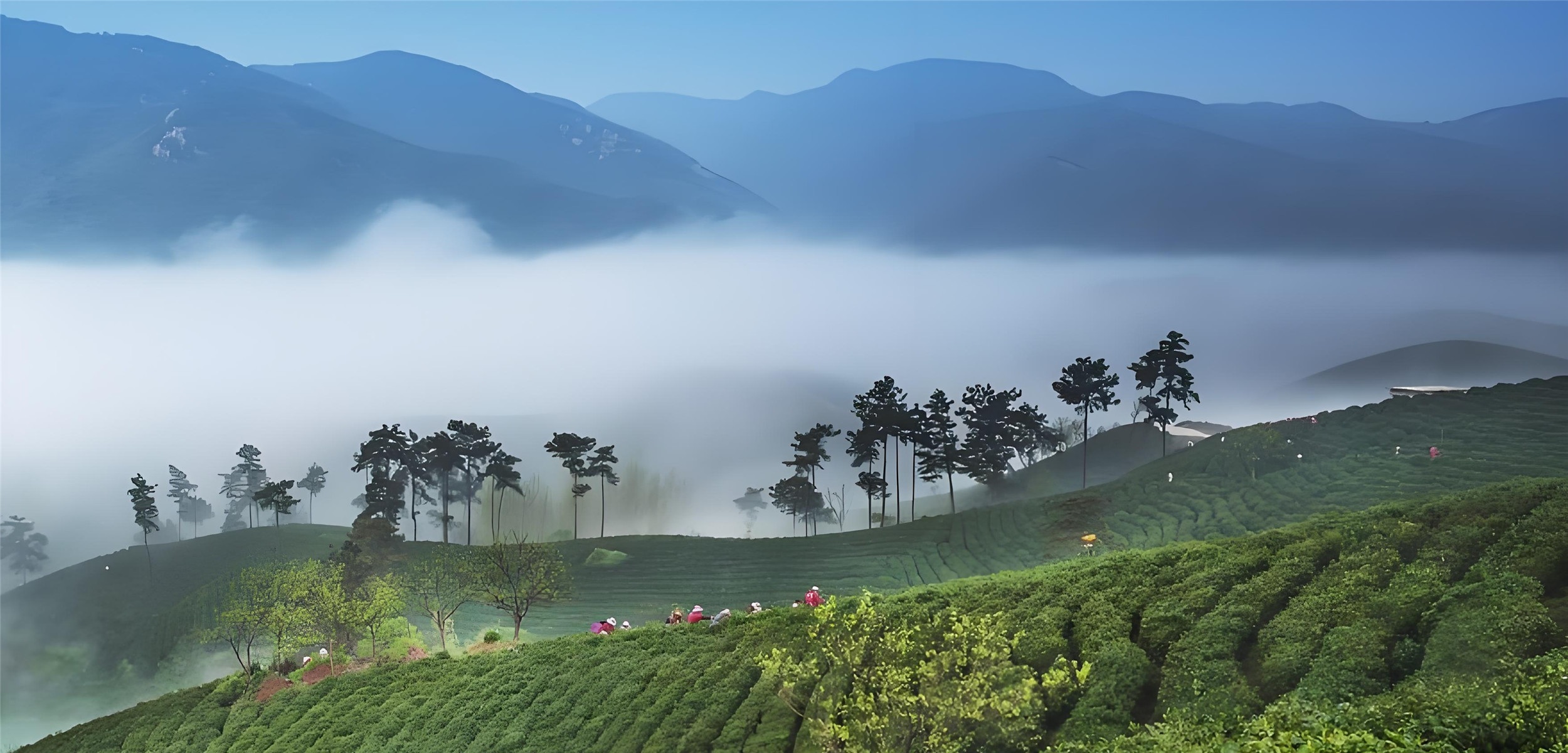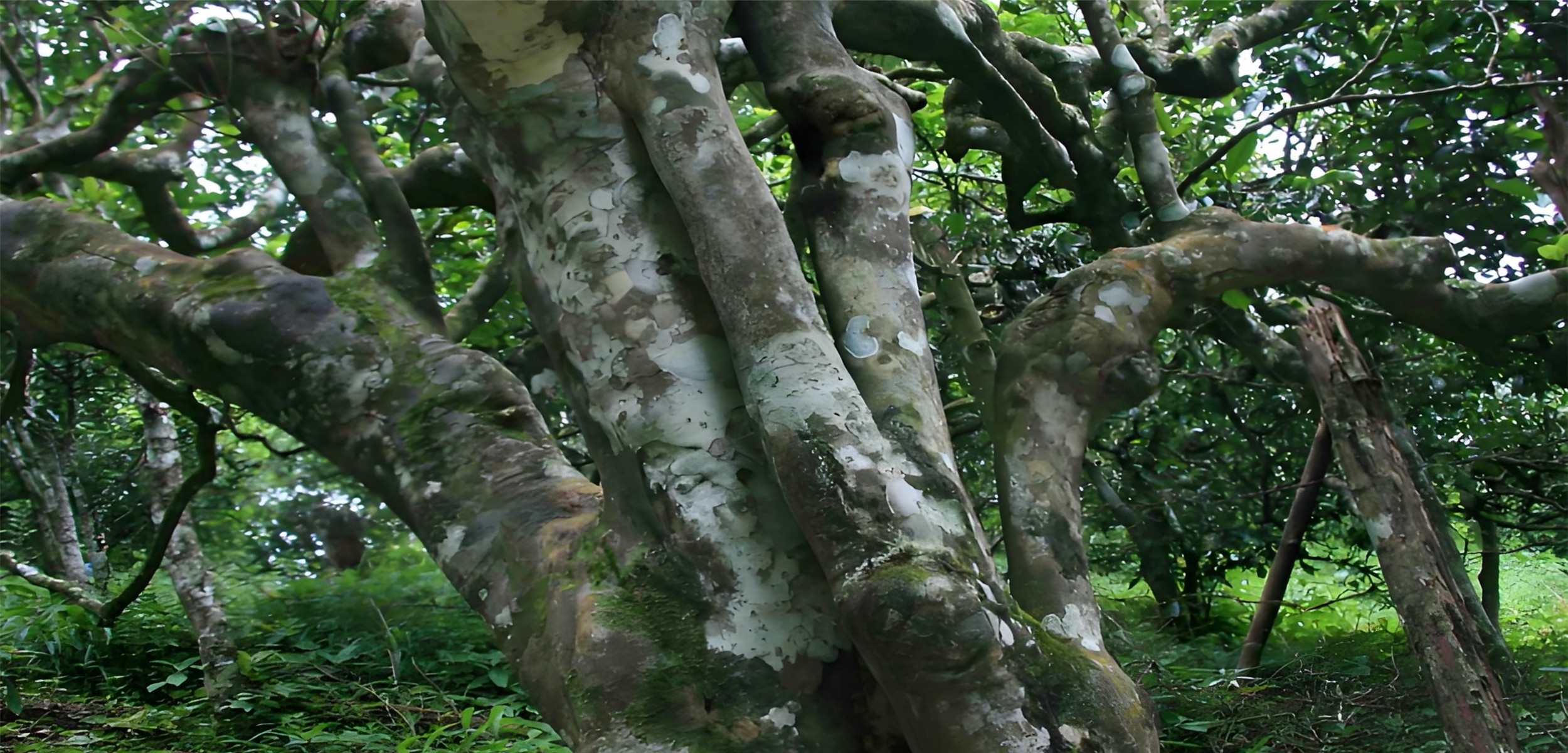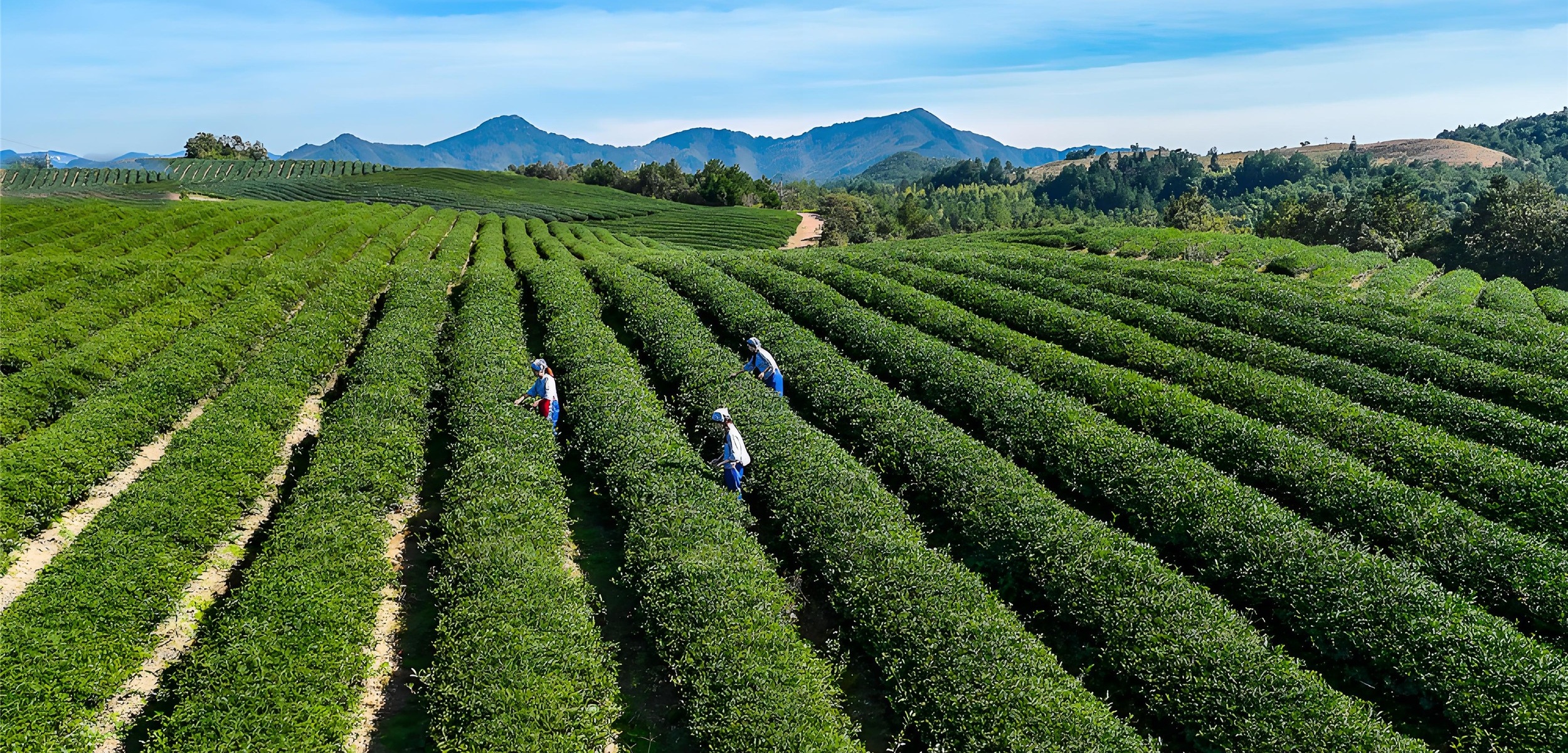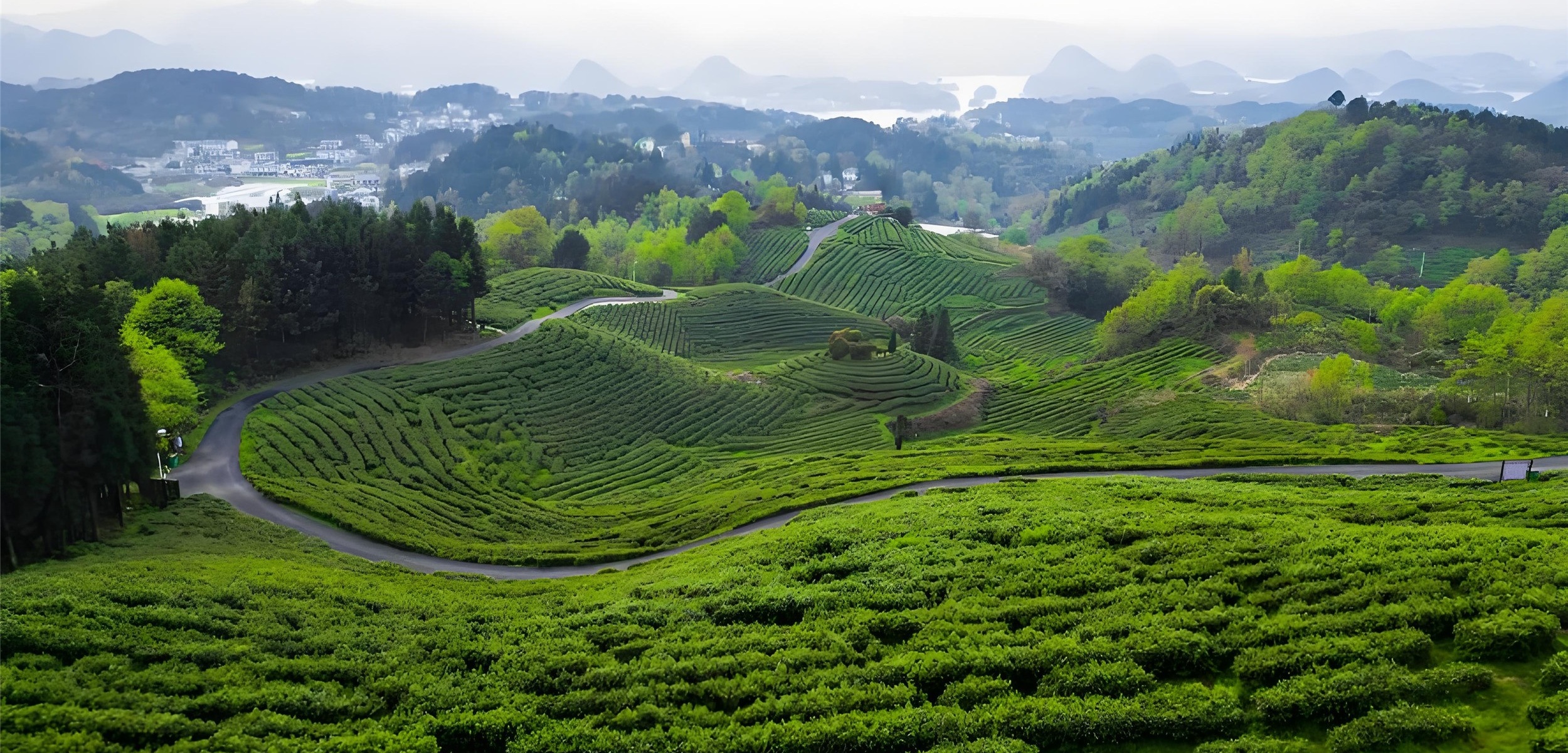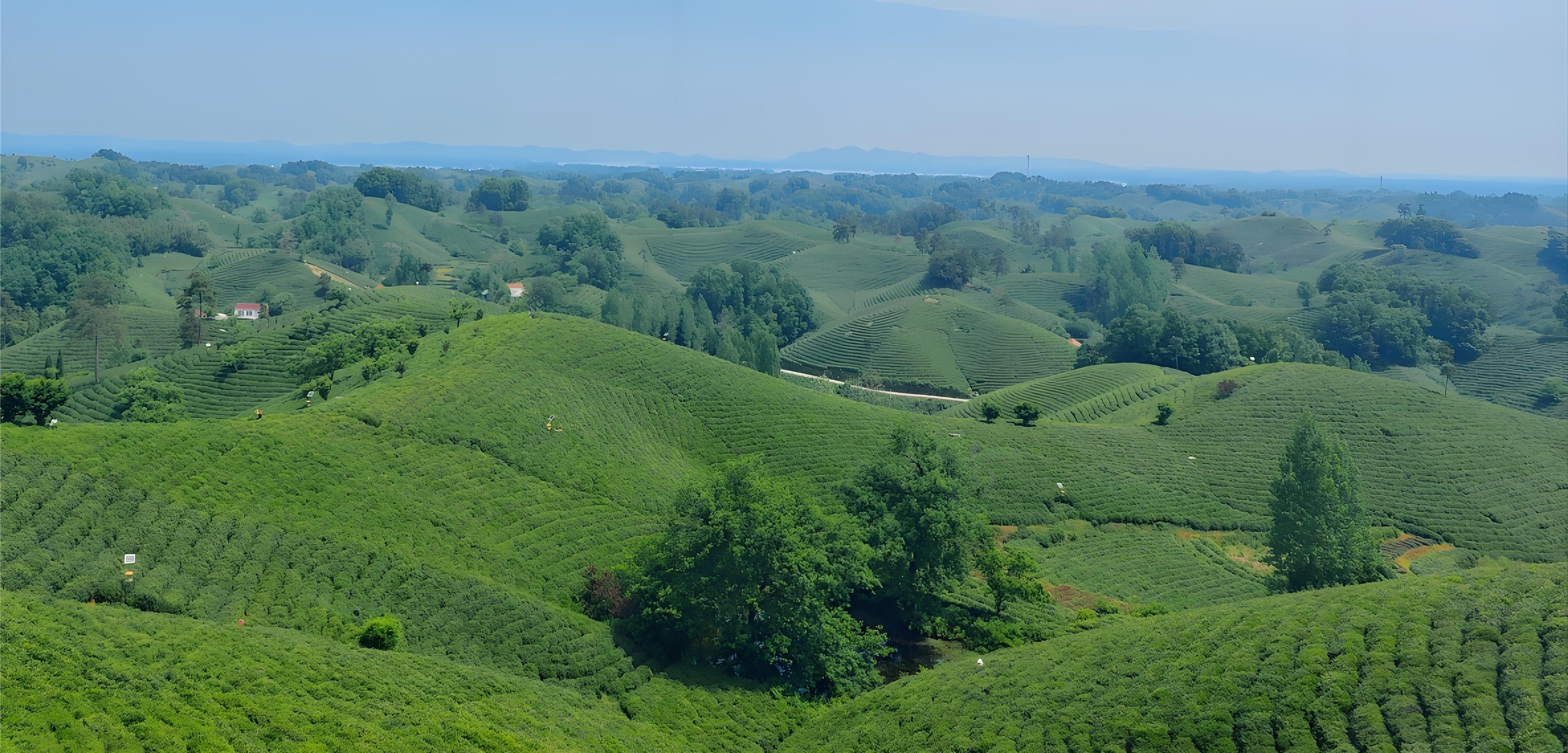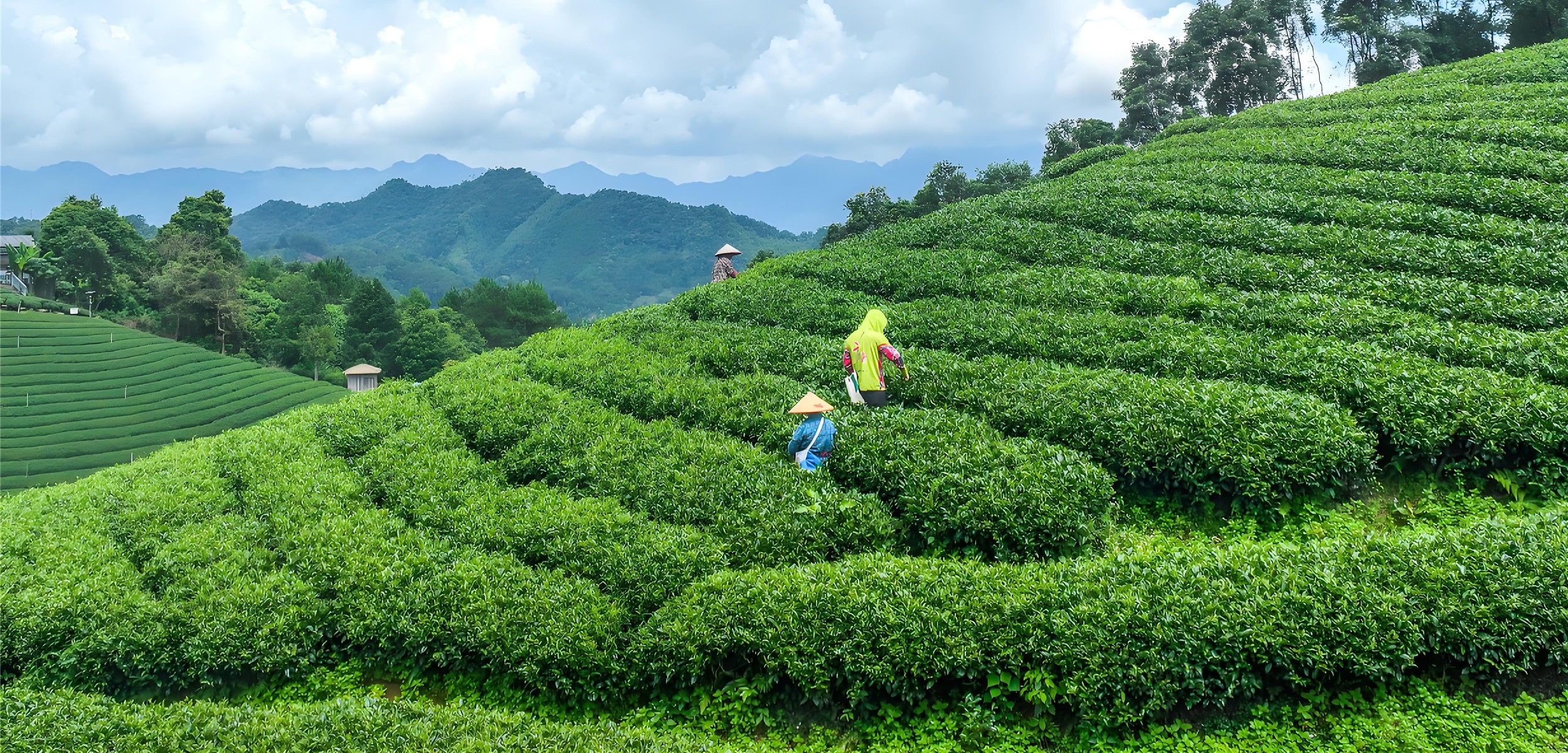茶叶怎么泡才好喝?掌握这4个诀窍,秒变泡茶高手!How to brew tea to make it taste good? Master these 4 tricks and become a master of brewing tea in seconds!
百度-青瞳视角
随着大家对健康的关注,喝茶也越来越受到欢迎。生活水平的提高,也使得许多人可以追求更好的茶。不过许多人都有这样的困惑:明明是“很好”的茶,怎么泡出来也就那么回事呢?
这里,我们来深入地说说“泡茶”这件事。
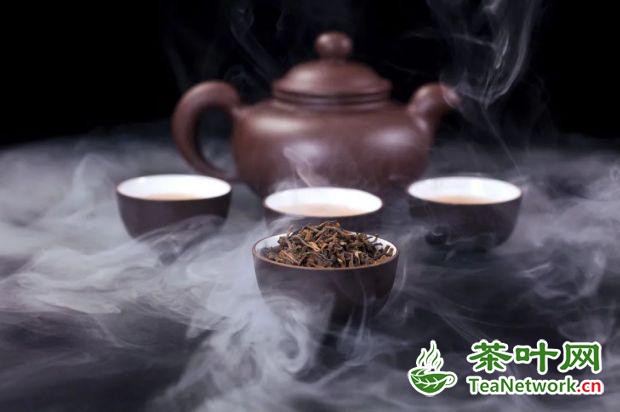
图虫创意
01
泡茶的实质
茶叶在制作的过程中,有一个工序叫做揉捻,就是以机械力作用于茶青,按压、揉搓,使叶片里的风味物质——如带来苦、涩、鲜、甜、香的物质——茶多酚、茶氨酸、咖啡因、果胶质和茶多糖类,一部分被带到了叶片表面,一部分保留在叶片中,这样在泡茶时,先是叶片表面的可溶性物质溶解在水里,继而叶片里面的物质移动到叶片表面,然后再溶解到水中,形成有一定黏稠度的、滋味丰富的茶汤。也就是说,泡茶,实际上是一个物质溶解的过程,水为溶剂,可溶性的风味物质为溶质,溶质溶解的量,决定了茶汤的浓度;溶解的速度,影响了茶的耐泡度;各种物质溶解得是否和谐,影响茶汤的适口性。
风味物质在水中的溶解量、溶解速度和平衡性,受多种因素的影响。如茶叶的老嫩、茶条完整还是细碎、揉捻的紧结还是疏松,以及水浸出物总量的多少。当然也会受到水温、放多少茶叶、浸泡时间、甚至泡茶容器的形状等因素的影响,情况非常复杂,很难一言以蔽之。
以前,普通人家喝的茶叶,大多档次不高,原料相对比较成熟甚至粗老,叶片不容易吸水下沉,叶片里的可溶性物质少,且不容易溶解到水中,所以要多放茶叶,并且用刚烧开的沸水冲泡,才能泡出滋味。在那个物质不甚丰富的年代,食物的浓度高就意味着好啊!
现在,制茶技术不断精进,茶叶品种也很丰富,人们的茶叶消费意识和消费水平都提高了,各种档次的茶叶都能喝到,很多优质茶叶,一味地多放茶开水泡,并不利于风味的表达,茶汤浓强但协调不足。
要想每种茶叶都泡好喝,是要下点小功夫的,中国茶品种丰富,同一个品种恐怕还有好几个级别,需要反复冲泡实践比对,才能总结出一些规律性的方法,所谓熟能生巧嘛!
如果把泡茶比喻成一支交响乐队,那么泡茶者就是指挥,好喝的茶如同好听的乐曲,泡茶的过程,便是驾驭的过程。
02
怎样才能泡好茶
首先我们要确认,怎样才算把一泡茶“泡好”了。好喝、这款茶应有的品质特征表达出来了、好的风味能够维持相对长的时间,应该是“泡好”的三个基本指标。
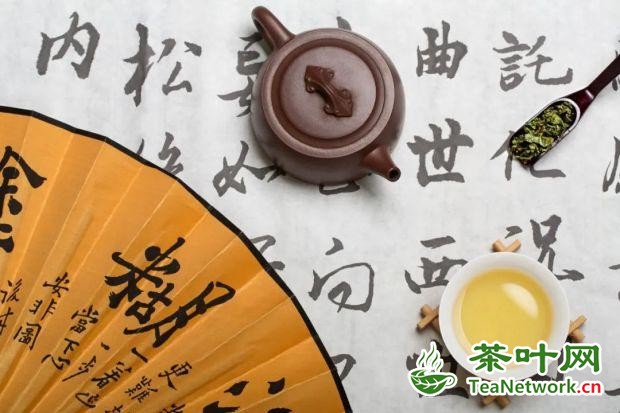
图虫创意
泡好一款茶,首先要了解泡茶的“三要素”——置茶量、泡茶水温和浸泡时间。
初学泡茶的人经常为壶里放多少茶而发愁,茶叶放少了茶汤寡淡没滋味,放多了茶汤苦涩影响口感。泡茶高手常用“茶水比”这个术语来描述茶叶的用量,就是茶叶和水(其实是指茶具的容积)的比例。
在用专业器具和方法泡茶时,通常的茶水比在1:15—1:25之间,因茶叶特性不同而有所差异,一般的绿茶、黄茶、白茶、红茶和花茶,可以选择1:25这个比例,即1克茶叶配25毫升的水。如果茶壶或盖杯的容积是100毫升,放4克茶叶,泡出的茶汤浓淡适中。乌龙茶和黑茶往往追求浓厚口味, 采用1:15茶水比的时候比较多。
如果是日常闷泡法泡茶,茶水比多在1:50—1:100之间,而煮茶呢,因为持续的高温,茶叶就要再少放一些,以1:150—1:200的茶水比为宜。
以上数据虽然精准,但也有不方便的地方,比如有时候我们无法得知泡茶壶的容积,就只好用简单的目测法,来确定放多少茶叶来。对于茶壶和茶杯来说,它的容积和高度是呈正比的,以容积不超过400毫升的壶或杯子为例,外形紧细或者近球形的茶,置茶量以铺满容器底部、厚度约0.5厘米为宜;如果比较疏松的茶,厚度在1-1.5厘米之间比较适中。
确定好茶叶量,泡茶水温也是有讲究的。通常形容不同水温的术语有:
高温水,指90-100℃的水;中温水,指90℃~80℃的水;低温水,指80℃以下的水。还有常温水、冰水等等。
大致的规律是,水温高,茶香明显,茶汤滋味浓强,容易显苦涩;水温低,茶香不高,茶汤滋味柔和但容易寡淡显水味。多数绿茶原料较嫩,咖啡因含量高,容易泡苦,用低温水泡比较好。红茶、白茶、花茶及黑茶,用中温水泡就很好喝,但像乌龙茶、普洱生茶和一些老茶,最好用高温水冲泡,才能使它们特有的风味尽情展现。对苦味和咖啡因比较敏感的人,可以尝试用温热水、甚至冰水来泡茶,损失一些香气,但茶汤几乎是不苦的。
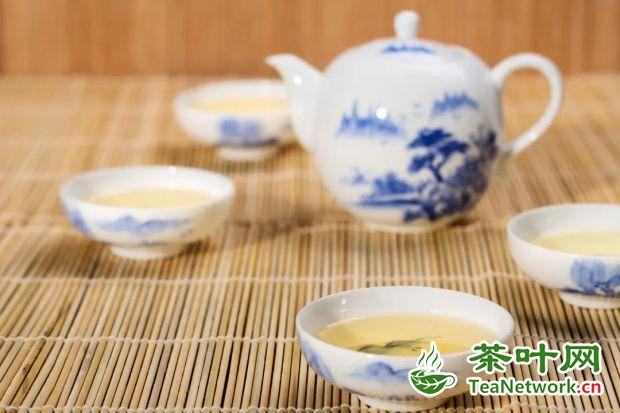
图虫创意
总之,泡茶水温同烹饪的火候一样,可以根据茶叶特点和我们想要的风味进行调整。冬天泡茶,由于环境温度低、茶具散热快,泡茶水温可以比平时略高。刚从冰箱里取出的茶叶温度较低,第一泡的水温可以提升一个级别,第二泡恢复正常。如果茶叶比较碎,甚至茶末居多,泡茶水温可以降一个级别,减轻苦涩。
茶泡的好不好,和每一泡的浸泡时间有很大关系。在专业泡茶的场景中,当置茶量、水温都是固定值,浸泡时间便成了泡茶高手们的角力点,单位精确到秒。
绿茶、乌龙茶和普洱生茶,风味易受浸泡时间的影响,所以在练习冲泡这些茶的时候,要先学会心中默默数秒,有时候差四五秒,茶汤滋味就有很大差别。白茶、红茶和黑茶,对浸泡时间更宽容一些,浸泡40秒还是60秒,差别不是很大。总之,专业泡茶,是以“秒”为单位来计算泡茶时间的。
如果是日常闷泡法,茶叶放的少了,浸泡时间自然就要长一些,以分钟计,高温水冲泡的话,一般3-5分钟比较好喝。如果是冷泡,浸泡时间就要按小时计算了,1个小时—4个小时之间,茶汤比较容易好喝。
最后,茶叶耐不耐泡,即一定份量的茶叶,能跑几次、几水或几杯,其实是和茶叶等级、置茶量、水温和每一泡的浸泡时间有关,泡茶高手,常常能够把一款茶冲泡更多次数、茶汤依旧协调好喝,这是需要长期实践、不断比对琢磨,才能达到的境界。
03
泡茶最好用什么茶具
泡茶是个技术活儿,最终目的是借助适当的器具和方法,把茶水泡好喝。而喝茶又是一件生活化的事情,不同生活场景下,其实都可以泡茶喝茶,方法论上略作调整即可。
如果对茶叶进行专业品鉴,从色香味形各个方面鉴赏茶叶的美,可以用紫砂壶、瓷壶或瓷质泡茶盖碗来泡茶,紫砂壶保温又透气,比较容易把茶泡的香韵平衡、特质尽现。瓷质盖碗虽然持握上有一定难度,新手容易被烫到,但浸泡时间好掌握,揭盖闻香比较方便。瓷壶介于两者之间,虽然冲泡的表现力不如紫砂壶,但一把壶什么茶都能泡,维护上不用像紫砂壶那么小心翼翼,倒也是个巨大的优点。
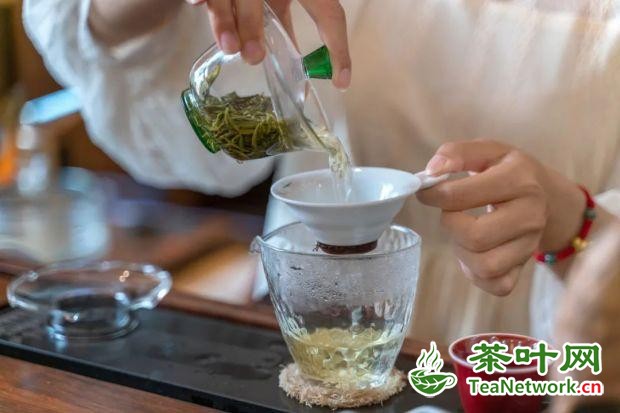
图虫创意
如果在办公室泡茶,可以使用带过滤内芯的泡茶杯,茶叶放在滤芯内,泡上一两分钟可以把滤芯连茶叶一起取出来,此时的茶汤保持在一个适口的浓度,不会因为茶叶长时间浸泡在水中而变得浓度过高不好喝,这叫“茶水分离”。办公室的忙碌没有规律可循,有时候刚泡上一杯茶就去处理公务了,等想起来喝茶,这杯茶已经又苦又涩难以下咽了。所以,在办公室泡茶,宜使用可以茶水分离的泡茶杯,又不会显得太过高调。
日常生活中,人比较多的时候泡茶,可以用三才杯或者大容积的茶壶泡茶。三才杯指的是直接喝茶用的盖碗,每个人人手一杯,蓄水、饮用随个人心意,但三才杯不适合泡白茶或者乌龙一类叶片比较大或者舒展的茶叶,泡绿茶、红茶和花茶都还是不错的。大容积的茶壶,无论是瓷壶、紫砂壶还是玻璃壶、铁壶或银壶,聚会时使用比较方便,只要把置茶量和浸泡时间计算好,一次能泡出很多适口的茶汤,主宾从容。
出门在外,旅途劳顿,喝茶是一种很好的减轻疲劳、补充水分的方式。但是,旅行毕竟不方便携带易碎品,热水也不一定走哪儿都有,便携式的保温杯,就是大多数人的选择了。只要是正规产品,保温杯泡茶是安全的,只是茶叶长时间浸泡在高温水中,容易苦涩浓强。所以,旅途中用保温杯泡茶时,可以进行三个方面的调整,一是少放点茶叶,茶水比以1:250为宜,二是可以把保温杯里的水温调整到80°C以下,三是可以选择原叶袋泡茶,或者将茶叶装进无纺布小茶袋,再放到保温杯里冲泡,方便饮用和清理。另外,保温杯还特别适合做冷泡茶,尤其是盛夏时节,一口沁凉的冰茶入口,爽酷极了。
04
泡茶用什么水好
泡茶用水首先要符合食品安全中有关饮用水的要求,干净卫生,各项指标合格。从这点来说,在户外自然环境中接取的山泉水、湖泊溪流水这些没有经过净化和检测的水,泡茶时煮沸时间要稍微延长一点,而且这些水要随用随取随烧,不要储藏,以免微生物大量滋生。
泡茶的水对茶叶风味的影响主要在两个方面:硬度和酸碱值(pH值)。
水的硬度主要指水中的钙离子、镁离子等的含量,包括碳酸盐硬度和非碳酸盐硬度。
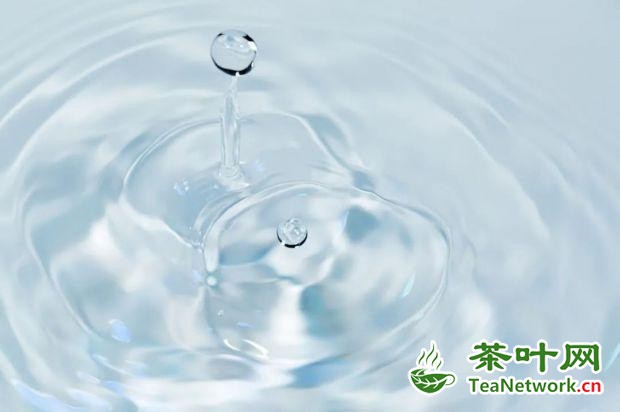
图虫创意
碳酸盐硬度:主要是由钙、镁的碳酸氢盐[Ca(HCO3)2、Mg(HCO3)2]所形成的硬度,这些硬度经加热之后可以分解成沉淀物从水中除去,所以被称为暂时硬度。而非碳酸盐硬度主要是由钙镁的硫酸盐、氯化物和硝酸盐等盐类所形成,这类硬度不能用加热分解的方法除去,所以称为永久硬度,如CaSO4、MgSO4、CaCl2、MgCl2、Ca(NO3)2、Mg(NO3)2等。
我们暂且以碳酸钙浓度表示的硬度把水大致分类:
·0~75mg/L 极软水
·75~150mg/L 软水
·150~300mg/L 中硬水
·300~450mg/L 硬水
·450~700mg/L 高硬水
·700~1000mg/L 超高硬水
·>1000mg/L 特硬水
泡茶使用极软水、软水和较低硬度的中硬水,都是不错的选择,后面几种水质过硬,即水中钙镁离子含量太高,会影响茶香的释放,也会影响风味物质的溶出,令茶汤或寡淡、或苦涩。比如自来水,硬度一般介于硬水和高硬水之间,泡出的茶香气和滋味至少降低了两三个档次。值得注意的是,很多山泉水和矿物质水硬度也非常高,它们喝起来是很好的水,有的售价不菲,但并不适合泡茶。
如何获知水的硬度呢?可以购买一支检测水的硬度计。一般来说,硬度计显示数值在200以内的水,都可以放心地用来泡茶。
硬水可以通过煮沸去除一部分硬度,也可以使用活性炭吸附,最简单的方法,就是直接使用纯净水等软水泡茶,可以比较真实地反映出茶叶的色香味。
酸碱度描述的是水溶液的酸碱性强弱程度,用pH来表示。热力学标准状况时,pH=7的水溶液呈中性,pH<7者显酸性,pH>7者显碱性。水中含有一些离子,所以有的水呈弱酸性,有的水呈弱碱性。
泡茶用水的pH值主要通过调控茶多酚的变色而对茶汤颜色有些许影响。同样一款茶,同时用弱酸性水和弱碱性水冲泡,前者汤色浅谈明亮,后者汤色略深一点,而对滋味的影响差异并不是特别明显。所以,如果泡汤色原本就浅淡的茶叶,如绿茶、黄茶、轻发酵的乌龙茶等,可以选择弱酸性水,而泡红茶、老茶这类汤色偏深的茶,不妨选择弱碱性水,使汤色更加红浓明亮。
水中铁离子的含量,也会影响茶汤的颜色和滋味。铁离子含量过高时,茶汤寡淡失衡,冷却后还会在表面形成一层褐色的薄膜状沉淀物,很不好看。水管生锈、煮水器镀层破损生锈等情形下,水中铁离子容易超标,因此再次印证了“铁壶煮水可以补铁”等说法是无稽之谈。
作者|于佳平
审核|云无心 美国普度大学食品工程博士
(科学辟谣)
With the increasing attention to health, drinking tea is becoming more and more popular. The improvement of living standards has also enabled many people to pursue better tea. However, many people have this confusion: even though it is "very good" tea, how can it be brewed like that?
Here, let's delve deeper into the topic of "brewing tea".
Tu Chong Creative
01
The essence of brewing tea
In the process of tea production, there is a process called rolling, which applies mechanical force to the tea leaves, pressing and kneading, so that the flavor substances in the leaves, such as bitter, astringent, fresh, sweet, and fragrant substances - tea polyphenols, theanine, caffeine, pectin, and tea polysaccharides - are partially carried to the surface of the leaves and partially retained in the leaves. In this way, when brewing tea, the soluble substances on the surface of the leaves are first dissolved in water, and then the substances inside the leaves move to the surface of the leaves, and then dissolve into water, forming a tea soup with a certain viscosity and rich taste. That is to say, brewing tea is actually a process of substance dissolution, with water as the solvent and soluble flavor substances as solutes. The amount of solute dissolution determines the concentration of the tea soup; The speed of dissolution affects the steepness of tea; Whether various substances dissolve harmoniously affects the palatability of tea soup.
The solubility, dissolution rate, and equilibrium of flavor compounds in water are influenced by various factors. Such as the age and tenderness of tea leaves, whether the tea strips are intact or finely divided, whether they are tightly rolled or loose, and the total amount of water extract. Of course, it will also be affected by factors such as water temperature, how many tea leaves to put in, soaking time, and even the shape of the tea brewing container. The situation is very complex and difficult to summarize in a word.
In the past, the tea leaves that ordinary people drank were mostly of low grade, with relatively mature or even coarse raw materials. The leaves were not easy to absorb water and sink, and the soluble substances in the leaves were low and not easily dissolved in water. Therefore, more tea leaves were added and brewed with freshly boiled water to obtain the desired flavor. In that era when materials were not very abundant, a high concentration of food meant good!
Nowadays, tea making technology is constantly improving, and the variety of tea leaves is also very rich. People's awareness and level of tea consumption have increased, and various grades of tea can be enjoyed. Many high-quality tea leaves are not conducive to the expression of flavor, and the tea soup is strong but lacks coordination.
To make every type of tea delicious, it takes some effort. Chinese tea has a wide variety of varieties, and there may be several levels of the same variety. It requires repeated brewing practice and comparison to summarize some regular methods. As the saying goes, practice makes perfect!
If tea brewing is compared to a symphony orchestra, then the tea brewer is the conductor, and delicious tea is like beautiful music. The process of brewing tea is the process of mastering it.
02
How to make good tea
Firstly, we need to confirm what constitutes "brewing" a cup of tea. Good taste, the expression of the quality characteristics that this tea should have, and the ability to maintain a good flavor for a relatively long time should be the three basic indicators of "good brewing".
Tu Chong Creative
To brew a good tea, the first step is to understand the "three elements" of brewing tea - the amount of tea to be brewed, the temperature of the tea water, and the soaking time.
Beginners of brewing tea often worry about how much tea to put in the pot. If there are too few tea leaves, the tea soup will be bland and tasteless, and if there are too many tea leaves, the bitterness will affect the taste. Tea masters often use the term "tea to water ratio" to describe the amount of tea used, which is the ratio of tea leaves to water (actually referring to the volume of the tea set).
When using professional tools and methods to brew tea, the usual ratio of tea to water is between 1:15-1:25, which varies depending on the characteristics of the tea leaves. For general green tea, yellow tea, white tea, black tea, and flower tea, the ratio of 1:25 can be chosen, which is 1 gram of tea leaves mixed with 25 milliliters of water. If the capacity of the teapot or lid cup is 100 milliliters, add 4 grams of tea leaves, and the brewed tea soup will be of moderate strength. Oolong tea and black tea often pursue strong flavors, and when using a 1:15 ratio of tea to water, it is more common.
If using the daily steeping method to brew tea, the ratio of tea to water should be between 1:50-1:100. However, when boiling tea, due to the continuous high temperature, the amount of tea leaves should be reduced, and a tea to water ratio of 1:150-1:200 is appropriate.
Although the above data is accurate, there are also some inconveniences, such as sometimes we cannot know the volume of the teapot, so we have to use a simple visual inspection method to determine how many tea leaves to put in. For teapots and tea cups, their volume and height are directly proportional. Taking a teapot or cup with a volume of no more than 400 milliliters as an example, for tea with a compact or nearly spherical shape, the appropriate amount of tea to be placed is to cover the bottom of the container with a thickness of about 0.5 centimeters; If the tea is loose, a thickness between 1-1.5 centimeters is moderate.
Once the amount of tea leaves is determined, there are also considerations for the temperature of the brewed tea. The terms commonly used to describe different water temperatures are:
High temperature water refers to water at 90-100 ℃; Medium temperature water refers to water between 90 ℃ and 80 ℃; Low temperature water refers to water below 80 ℃. There are also warm water, ice water, and so on.
The general rule is that when the water temperature is high, the tea aroma is obvious, the taste of the tea soup is strong, and it is easy to show bitterness; The water temperature is low, the tea aroma is not high, and the taste of the tea soup is soft but easy to fade and show a watery taste. Most green tea ingredients are tender, have high caffeine content, and are easy to soak bitter. It is better to soak them in low-temperature water. Black tea, white tea, flower tea, and black tea taste great when soaked in medium temperature water, but for oolong tea, pu erh raw tea, and some old teas, it is best to brew them with high temperature water to fully showcase their unique flavors. People who are sensitive to bitterness and caffeine can try brewing tea with warm water or even ice water to lose some aroma, but the tea soup is almost not bitter.
Tu Chong Creative
In short, the water temperature for brewing tea is the same as the cooking heat, and can be adjusted according to the characteristics of the tea leaves and the flavor we want. In winter, when brewing tea, due to the low ambient temperature and fast heat dissipation of tea utensils, the water temperature for brewing tea can be slightly higher than usual. The temperature of the tea leaves that have just been taken out of the refrigerator is relatively low. The water temperature of the first brew can be increased by one level, and the second brew will return to normal. If the tea leaves are relatively broken, or even have a lot of tea powder, the water temperature for brewing tea can be lowered by one level to reduce bitterness.
The quality of tea brewing is closely related to the soaking time of each brew. In the context of professional tea brewing, when the amount of tea and water temperature are fixed, soaking time becomes a point of contention for tea masters, with units accurate to seconds.
Green tea, oolong tea, and raw Pu erh tea have flavors that are easily affected by soaking time. Therefore, when practicing brewing these teas, it is important to first learn to silently count a few seconds in your mind. Sometimes, a difference of four or five seconds can result in a significant difference in the taste of the tea soup. White tea, black tea, and black tea are more tolerant of soaking time, soaking for 40 seconds or 60 seconds, the difference is not very significant. In short, professional tea brewing is measured in seconds to determine the brewing time.
If it is a daily steeping method, if less tea is added, the soaking time will naturally be longer, measured in minutes. If brewed with high-temperature water, it is generally better to drink for 3-5 minutes. If it is cold brewed, the soaking time should be calculated in hours. Between 1 hour and 4 hours, the tea soup is easier to drink.
Finally, whether tea leaves can withstand steeping or not, that is, how many times a certain amount of tea leaves can be brewed, how much water or how many cups can be brewed, is actually related to the grade of tea leaves, the amount of tea left, the water temperature, and the soaking time of each steeping. Tea masters often brew a tea more times and the tea soup still tastes well. This is a state that requires long-term practice and continuous comparison and refinement to achieve.
03
What tea set is the best for brewing tea
Brewing tea is a technical task, with the ultimate goal of using appropriate tools and methods to soak the tea in water and make it taste good. And drinking tea is also a daily life thing. In different life scenarios, tea can be brewed and consumed with slight adjustments to the methodology.
If you want to professionally taste tea and appreciate its beauty from various aspects such as color, aroma, and shape, you can use purple clay teapots, porcelain teapots, or porcelain tea cups to brew tea. Purple clay teapots are insulated and breathable, making it easier to balance the aroma, flavor, and characteristics of the tea. Although holding a porcelain covered bowl can be difficult for beginners and can easily be scalded, the soaking time is easy to control and it is convenient to remove the lid and smell the fragrance. Ceramic teapots are in between the two. Although their brewing performance is not as good as that of purple clay teapots, they can brew any type of tea in one pot without the need for careful maintenance like purple clay teapots, which is also a huge advantage.
Tu Chong Creative
If brewing tea in the office, you can use a tea cup with a filter core. The tea leaves are placed in the filter core and soaked for one or two minutes to remove both the filter core and the tea leaves. At this time, the tea soup remains at a suitable concentration and will not become too strong and unpleasant to drink due to prolonged soaking of the tea leaves in water. This is called "tea water separation". The busyness of the office has no discernible pattern. Sometimes, as soon as a cup of tea is brewed, one goes to handle official business. By the time one remembers to drink tea, the tea is already bitter and astringent, making it difficult to swallow. So, when brewing tea in the office, it is advisable to use tea cups that can separate tea and water, without appearing too high-profile.
In daily life, when there are many people, tea can be brewed using a three cup or a large capacity teapot. The Sancai Cup refers to a covered bowl used for drinking tea directly, with each person holding a cup to store water and drink according to their personal preferences. However, the Sancai Cup is not suitable for brewing white tea or oolong tea with large or stretched leaves. It is still good for brewing green tea, black tea, and flower tea. Large capacity teapots, whether they are porcelain pots, purple clay pots, glass pots, iron pots, or silver pots, are more convenient to use during gatherings. As long as the amount of tea and soaking time are calculated properly, they can brew a lot of delicious tea soup at once, and the guests can be at ease.
Drinking tea is a great way to relieve fatigue and replenish fluids when traveling and feeling tired. However, traveling is not convenient for carrying fragile items, and hot water may not be available everywhere. Portable thermos cups are the choice for most people. As long as it is a legitimate product, brewing tea in a thermos cup is safe. However, if the tea leaves are soaked in high-temperature water for a long time, they may become bitter and strong. So, when brewing tea with a thermos cup during the journey, there are three adjustments that can be made: first, add less tea leaves, with a ratio of 1:250 between tea and water; second, adjust the water temperature in the thermos cup to below 80 ° C; third, choose to brew tea with original leaf bags, or put the tea leaves into non-woven tea bags and then put them in the thermos cup for brewing, which is convenient for drinking and cleaning. In addition, thermos cups are particularly suitable for making cold brewed tea, especially during the summer season. Taking a refreshing sip of iced tea is extremely cool.
04
What water is good for brewing tea
The water used for brewing tea must first meet the requirements for drinking water in food safety, be clean and hygienic, and meet all relevant standards. In this regard, the untreated and untested water from mountain springs, lakes, and streams collected in outdoor natural environments should be boiled for a slightly longer period of time when brewing tea, and these waters should be boiled as needed without storage to prevent the proliferation of microorganisms.
The influence of brewing water on tea flavor mainly lies in two aspects: hardness and pH value.
The hardness of water mainly refers to the content of calcium ions, magnesium ions, etc. in water, including carbonate hardness and non carbonate hardness.
Tu Chong Creative
Carbonate hardness: It is mainly formed by the bicarbonate of calcium and magnesium [Ca (HCO3) 2, Mg (HCO3) 2], and these hardness can be decomposed into precipitates and removed from water after heating, so it is called temporary hardness. The non carbonate hardness is mainly formed by salts such as sulfates, chlorides, and nitrates of calcium and magnesium. These types of hardness cannot be removed by heating decomposition methods, so they are called permanent hardness, such as CaSO4, MgSO4, CaCl2, MgCl2, Ca (NO3) 2, Mg (NO3) 2, etc.
We will roughly classify water based on the hardness expressed by the concentration of calcium carbonate for now:
·0~75mg/L extremely soft water
·75~150mg/L soft water
·150-300mg/L medium hard water
·300-450mg/L hard water
·450~700mg/L high hardness water
·700~1000mg/L ultra-high hardness water
·>1000mg/L Extra Hard Water
Using extremely soft water, soft water, and medium hard water with lower hardness is a good choice for brewing tea. The latter types of water have high calcium and magnesium ion content, which can affect the release of tea aroma and the dissolution of flavor compounds, making the tea soup either bland or bitter. For example, tap water generally has a hardness between hard water and high hardness water, and the aroma and taste of brewed tea are reduced by at least two or three grades. It is worth noting that many mountain spring water and mineral water have very high hardness, and they taste good. Some are expensive, but not suitable for brewing tea.
How to determine the hardness of water? You can purchase a hardness tester to test water. Generally speaking, water with a hardness tester reading below 200 can be safely used for brewing tea.
Hard water can be boiled to remove some hardness, or activated carbon can be used for adsorption. The simplest method is to directly use soft water such as purified water to brew tea, which can reflect the color, aroma, and taste of tea leaves more realistically.
The pH value describes the strength of the acidity or alkalinity of an aqueous solution, expressed in terms of pH. Under thermodynamic standard conditions, an aqueous solution with pH=7 is neutral, pH<7 is acidic, and pH>7 is alkaline. Water contains some ions, so some water is weakly acidic and some water is weakly alkaline.
The pH value of tea brewing water mainly affects the color of tea soup by regulating the color change of tea polyphenols. The same tea is brewed with both weakly acidic and weakly alkaline water. The former has a bright color, while the latter has a slightly darker color, and the difference in taste is not particularly significant. So, for tea leaves that are already light in color when soaked in water, such as green tea, yellow tea, light fermented oolong tea, etc., weak acidic water can be chosen, while for tea with darker soup color such as black tea and aged tea, weak alkaline water can be chosen to make the soup color more red, strong, and bright.
The content of iron ions in water can also affect the color and taste of tea soup. When the iron ion content is too high, the tea soup becomes bland and unbalanced, and after cooling, a brown film like precipitate will form on the surface, which is not very attractive. In cases where water pipes rust or the coating of the water boiler is damaged or rusted, the iron ions in the water are prone to exceed the standard, which once again confirms that the claim that "boiling water in an iron pot can replenish iron" is unfounded.
Author | Yu Jiaping
Review | Yunxinxin holds a PhD in Food Engineering from Purdue University in the United States
(Scientific refutation of rumors)
